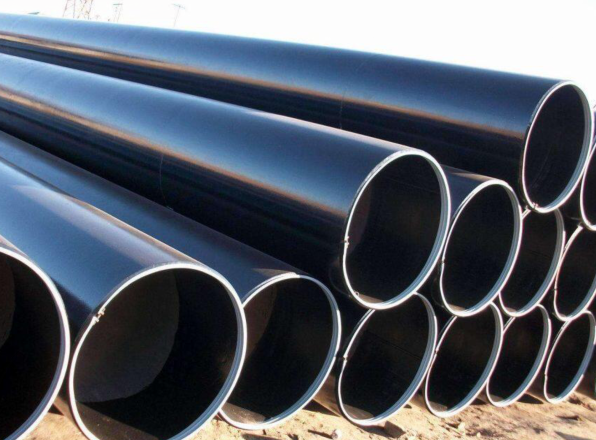Electric Resistance Welded (ERW) Pipe is a type of steel pipe formed by welding steel strip or plate together using the heat and pressure of resistance. Steel pipe shapes primarily include round tubes, square tubes and rectangular tubes. It offers significant advantages in modern manufacturing, making it one of the most popular steel pipe manufacturing processes. This article focuses on the benefits and drawbacks of using ERW pipe.
Benefits of Using ERW Pipe:
1. High Production Efficiency and Outstanding Cost-Effectiveness
Cost-efficiency is the core advantage of ERW pipe.
Continuous Production: The electric resistance welding process uses coiled steel (steel strip) as raw material, enabling uninterrupted, continuous forming and welding, resulting in extremely high production speeds.
Low Consumption: Compared to seamless pipe, which requires piercing and rolling, the ERW process offers higher material utilization and reduces waste.

Lower Energy Consumption: The welding process primarily uses high-frequency current to heat the weld edge, rather than heating the entire billet. Therefore, energy consumption is significantly lower than that of seamless pipe production.
Low Cost: ERW pipes are typically 20%-30% cheaper than seamless pipes of similar specifications, offering a significant cost advantage in large-volume purchases.
2. High-Quality Welds and High Strength
It's a common misconception that welds in ERW pipes are inherently weak. In reality:
Metallurgical Bonding: High-frequency currents instantly heat the edges of the tube billet to a molten state. The pressure of the extrusion rollers creates a grain-to-grain bond between the parent metals, resulting in a chemical composition consistent with that of the parent metals.
High Weld Strength: High-quality ERW welds can achieve strength comparable to or even slightly higher than that of the parent metal (due to a slight heat treatment effect), meeting the strength requirements of most structural applications. The weld width is narrow, resulting in a fine internal grain structure and stable performance.
Internal Burr Removal: Modern ERW production lines are equipped with internal burr removal devices to ensure a smooth inner pipe surface that does not affect fluid flow.
3. High Dimensional Accuracy and Excellent Surface Finish
Cold Rolling: The ERW process typically uses steel coils or strips rolled at room or lower temperatures, resulting in extremely precise dimensional control and tight tolerances.
Excellent Surface Quality: Using high-quality cold-rolled or hot-rolled steel strip as raw material, the finished pipes are smooth, free of scale and pitting (compared to hot-rolled seamless pipes), making them more suitable for applications where they are visible or require painting.
4. High Flexibility, Capable of Producing a Wide Range of Specifications
Uniform Wall Thickness: The wall thickness of ERW pipes is determined by the thickness of the steel strip, resulting in a very uniform wall thickness across the entire pipe body, unlike seamless pipes, which may exhibit eccentricity.
Wide Range of Specifications: By replacing the forming rollers and welding machine, the same line can produce products of varying diameters and wall thicknesses, from small furniture pipes to large pile pipes, offering far greater flexibility than seamless lines.
Capable of Producing Large Diameter,
Thin-Walled Pipes: This is difficult to achieve with seamless lines, as seamless pipes typically have thicker walls at larger diameters.
5. Environmental Protection and Energy Saving
The production process does not require heating the steel billet to extremely high temperatures (above 1200°C) like
hot-rolled seamless pipe, resulting in lower overall energy consumption and carbon emissions, better meeting the requirements of modern green manufacturing.
Drawbacks of Using ERW Pipes:
1. Potential Risk of Weld Defects
High Process Control Requirements: Improper control of welding parameters (current, speed, and pressure) can result in defects such as incomplete penetration, slag inclusions, and cracks. These defects can act as stress concentration points, impacting fatigue life.
Raw Material Sensitivity: The cleanliness of the steel strip edge (e.g., rust and impurities) can affect weld quality.
2. Lower Pressure Capacity and Reliability than Seamless Pipes
This is the most critical drawback. Despite its high weld strength, it remains a potential weak link under conditions of extreme high pressure, alternating loads, or low-temperature shock. Seamless pipes offer superior reliability due to their overall consistency.
Therefore, seamless pipes are mandatory for critical pressure-bearing equipment (such as boilers, high-pressure oil and gas pipelines), nuclear power plants, and other applications.
3. Uneven Metallurgical Properties in the Weld Area
Heat-Affected Zone (HAZ): During welding, the area near the weld is heated, resulting in slight differences in grain structure and mechanical properties compared to the base metal. While this can be improved through subsequent heat treatment, it cannot be completely eliminated.
Differential Corrosion Resistance: In certain corrosive environments, slight differences in composition and structure between the weld area and the base metal may lead to electrochemical corrosion, known as weld corrosion.
4. Historical Reputation Issues
Old Low-Frequency Welded Pipe: Early low-frequency ERW pipes were of inferior quality, with numerous weld defects, leading to numerous accidents and creating a long-standing negative impression for the entire ERW pipe industry. Although modern high-frequency welding technology has completely resolved this issue, this prejudice still persists in some traditional industries.
Conclusion:
The benefits of using electric resistance welded (ERW) pipe can be summarized as: achieving the highest production efficiency and the lowest overall cost while maintaining sufficient strength and precision. It's ideally suited for cost-sensitive, high-volume applications that don't involve extreme pressures or harsh environments, such as building structures, machinery manufacturing, home furnishings, and vehicle frames.
Simply put, ERW pipe meets 90% of industrial needs, while seamless pipe addresses the most demanding challenges in the remaining 10%. When choosing between seamless pipes, consider the actual application conditions, budget, and industry standards, rather than blindly pursuing seamless pipe. For the vast majority of common applications, ERW pipe offers the most cost-effective option.
Read more: Cold Drawn ERW Pipe or Carbon Steel ERW Pipe Specification


